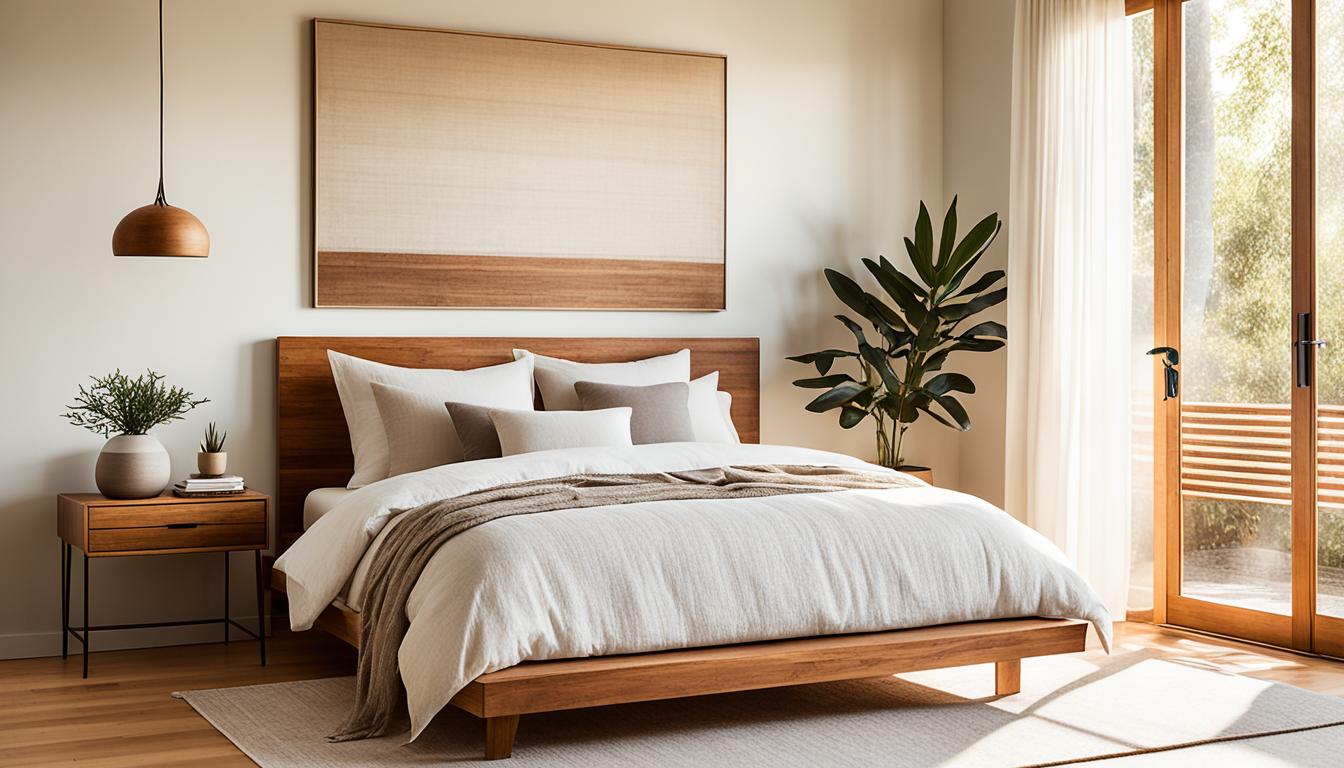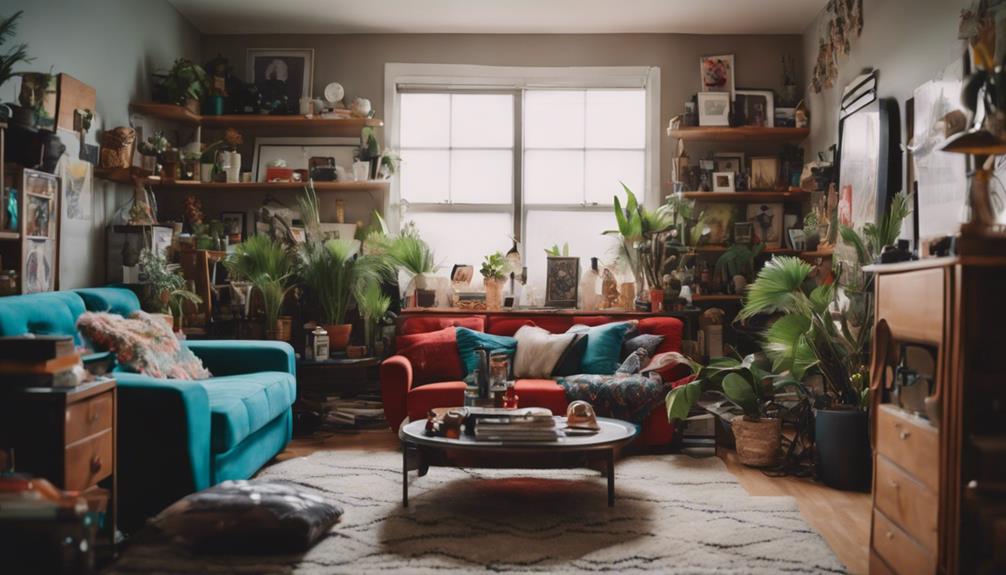In today’s fast-paced world, technology is ubiquitous. Lily, who was feeling inundated by incessant notifications and excessive screen time, observed a decline in her overall quality of life. She discovered that over 60% of Americans are tethered to their phones, which served as a catalyst for her to make a change.
She made her living room and bedroom tech-free zones. These became places for her to relax and connect with her loved ones. Lily found joy in reading and deep conversations again. This significantly improved her happiness and mental health.
This article highlights why a digital detox is crucial. It shows you how to create tech-free areas at home. Making these spaces helps bring back mental focus, boost your wellness, and strengthen relationships amid screen overload.
Key Takeaways
- Over 60% of Americans feel addicted to their phones.
- Establishing tech-free zones can significantly improve mental health and wellness.
- Individuals report increased productivity and focus after implementing regular digital detoxes.
- Creating screen-free spaces encourages deeper connections with loved ones.
- Boundaries like tech-free windows can help maintain better relationships and reduce stress.
Understanding the Need for a Digital Detox
The modern world makes it hard to escape technology, as it’s everywhere in our lives. This always-on connection worries those who want to improve their Mental Health. Screens can mess with our sleep, make stress worse, and reduce face-to-face time, leaving us feeling lonely and anxious.
Wellness experts suggest having places in the home where tech isn’t allowed to boost mood and health. By making the bedroom or dining room tech-free, deeper bonds with family and friends can form. Setting clear tech rules, like no-phone dinners, can really improve these relationships and our Mental Health.
- Stocking tech-free zones with analog hobbies such as books, journals, and musical instruments encourages healthier distractions.
- Maintaining a designated catch-all area for technology, such as a charging station, helps reduce reliance on devices.
Limiting digital use has its challenges, like being hard for some hobbies, but finding balance is key. Making small changes and rules personalized to you can boost wellness without feeling extreme. Studies show more people are getting hooked on digital devices, which highlights the need to manage their effect on Mental Health.
Setting firm device boundaries and cutting back on needless alerts can lessen distractions. Finding hobbies off-screen, like going outside or reading, can make life richer and lessen our reliance on screens.
| Strategy | Benefit |
|---|---|
| Creating Tech-Free Zones | Fosters deeper connections, reduces distractions |
| Setting Digital Curfews | Improves sleep hygiene, enhances overall well-being |
| Engaging in Offline Activities | Provides a sense of accomplishment, fosters creativity |
| Mindful Consumption of Digital Content | Avoids aimless scrolling, promotes engagement in real life |
The Negative Impact of Technology on Our Lives
Too much technology is becoming a big worry. It causes many bad effects. A main problem is getting too hooked on screens, which is bad for our mental health. Studies show that relying too much on technology can make us less creative. It also makes us want quick rewards, hurting our ability to think deeply.
Being addicted to screens can hurt our relationships, too. People spend more time with their gadgets than with loved ones. This makes them feel less connected and happy, causing problems in relationships.
Also, using too much technology can make it hard to get along with others. Constantly using devices means we miss out on real-life lessons needed for social skills. Too much tech can also make it hard to focus. Trying to do many things at once because of technology can lower how much we get done.
Another issue is how technology affects our sleep. The blue light from screens messes with our sleep cycles. This makes it hard to fall asleep and lowers sleep quality. We end up feeling tired and not as healthy overall.
The table below summarizes the negative impacts of technology on daily life:
| Impact Area | Negative Effects |
|---|---|
| Creativity | Reduced due to the quest for instant gratification |
| Relationships | Diminished social connections and satisfaction |
| Social Intelligence | Reduced capacity to learn from real-life experiences |
| Concentration | Difficulty focusing and reduced productivity |
| Sleep Quality | Disruption caused by blue light exposure |

Benefits of Establishing Tech-Free Zones
Having places in your home without technology brings many good things. It helps improve relationships within the family. This happens by encouraging deep talks and stronger connections. When phones and computers are out of reach, everyone listens more and bonds grow stronger.
These special zones also spark creativity. They push people to do things like paint, craft, or read instead of being glued to screens. Rediscovering old hobbies can make life more joyful and interesting.
Another plus is better sleep. Blue light from gadgets can mess with sleep. Cutting back on tech before bed can help you sleep better. This leads to waking up feeling more rested and being more productive all day.
- People who try taking breaks from tech often feel less stressed and anxious.
- Making tech-free times regular, like on weekends, builds good habits.
- Keeping track of your tech-free journey keeps you motivated and focused.
In conclusion, tech-free zones do more than reduce distractions. They promote healthier relationships, spark creativity, and improve our well-being. It’s about making more space for what truly matters.
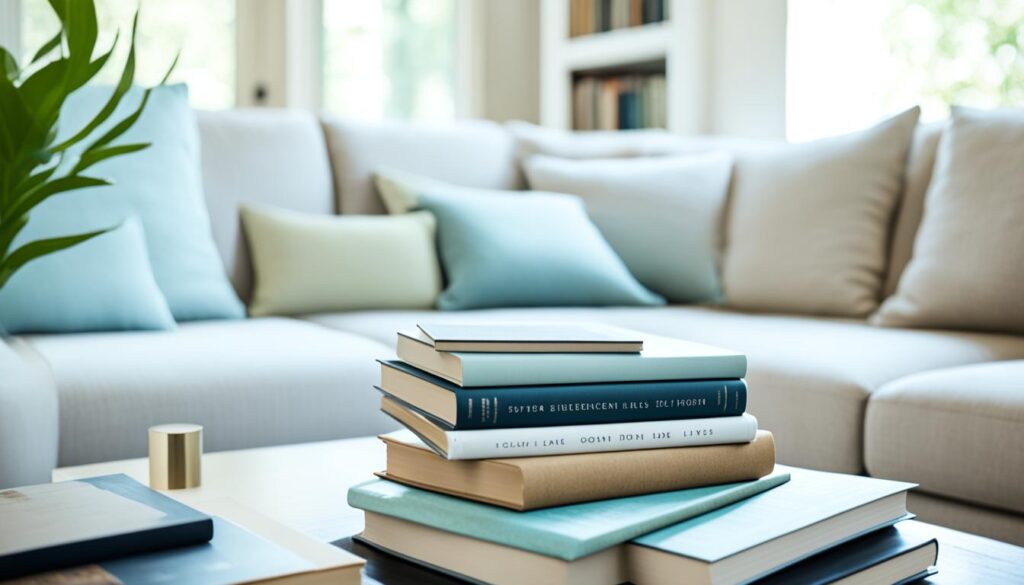
| Benefits | Description |
|---|---|
| Improved Relationships | Enhanced face-to-face communication and emotional connections. |
| Enhanced Creativity | Opportunities to engage in fulfilling activities. |
| Better Sleep Quality | Reduced blue light exposure leading to improved rest. |
| Reduced Stress | Decreased anxiety levels through mindfulness and focus. |
Digital Detox: Designing Tech-Free Zones in Your Home
We depend a lot on technology every day. It’s important to have spaces at home without screens and devices. Creating a balanced home means finding the best spots for tech-free zones. These areas help us connect better and find peace away from digital noise.
Identifying Key Areas for Tech-Free Spaces
When planning Tech-Free Zones, some spots in your home are perfect for using less tech. You should focus on:
- Bedrooms: A peaceful place for sleep, without distractions.
- Dining Rooms: Where family comes together to share meals.
- Living Rooms: Made for relaxing and chatting.
- Designated Relaxation Nooks: Quiet corners to enjoy a book or meditate.
Choosing the right space planning in these areas boosts wellbeing. It encourages real-life interactions over digital superficial ones.
Visualizing Your Ideal Tech-Free Zone
Imagining your tech-free haven is key. To make it welcoming, think about adding these elements:
| Element | Description |
|---|---|
| Natural Elements | Incorporate plants and sunlight for a calm vibe and to help relax. |
| Comfortable Seating | Pick chairs or cushions that support unwinding without tech. |
| Engaging Decor | Put up art or decor that starts conversations and makes you think. |
| Mindful Color Palettes | Use calming colors to ease stress and create a serene environment. |
Using space planning this way makes sure tech-free zones help with your digital detox. These spaces allow for deeper connections and a healthier life in our plugged-in world.
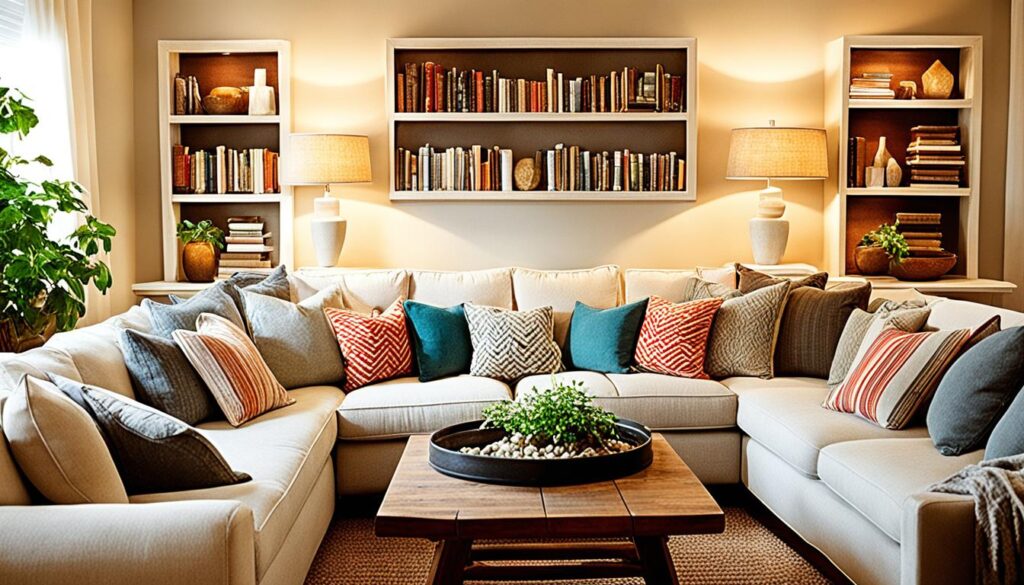
Creating a Tech-Free Bedroom
A Tech-Free Bedroom is key for amazing sleep. It should be your calm escape, away from anything that messes with peace and sleep. One good move is starting Screen-Free Routines. This helps you relax without the pull of screens.
Establishing Screen-Free Bedtime Routines
Starting a screen-free bedtime routine helps a lot. Begin to relax an hour before bed. Spend this time doing soothing things, not on your phone or computer. You can:
- Read a book
- Try mindfulness or meditation
- Journal your thoughts
- Enjoy some calming music
Switch screens for these relaxing activities to sleep better. Also, keeping gadgets out of the bedroom makes it a zen zone. These habits boost both sleep and mood.
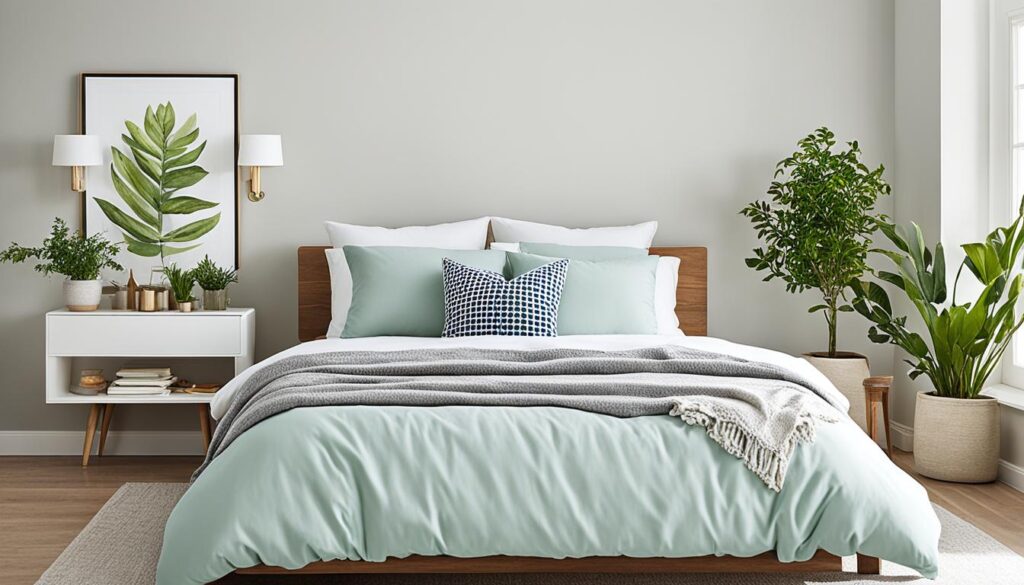
Designating Time for ‘People’ Interaction
Setting aside tech-free times for Family Time is crucial in building strong family ties. These moments allow for Social Interactions without screen distractions, bringing everyone closer. By making certain meals Tech-Free Meals, family members can enjoy both the food and each other’s company more.
Having regular nights for just ‘people’ interaction boosts family connections. It encourages talking and sharing experiences together. Life without screens leads to better understanding of each other’s emotions and strengthens family bonds. Such times help everyone prefer real conversations over online ones, leading to healthier relationships.
Setting simple rules like no phones at dinner or having scheduled times without screens helps everyone interact more. This not only reduces screen time but also makes each person feel important and listened to. It’s key for creating real, deep connections within the family.

Fostering Healthy Distractions in Tech-Free Zones
Making spaces without tech can really help family time and personal happiness. Setting up these areas with healthy distractions encourages families to do creative activities without looking at screens. Using books, art supplies, and board games makes family members interact more.
This helps fight the negative feelings from always being online. It also makes family time richer.
Engaging with Arts, Books, and Games
To create a space full of creativity and connection, think about this:
- Fill your shelves with a wide range of books for different interests and ages.
- Keep art materials like paints, markers, and sketchbooks for expressing creativity.
- Have many board games to encourage working together and thinking, which brings families closer.
Set aside special times for these creative activities at home. Families that do this find they connect more and communicate better. Also, spending time on fun distractions means less time on digital devices. This is good for mental health and staying in the moment.
| Activity | Benefits | Frequency |
|---|---|---|
| Reading | Enhances focus and improves vocabulary | Daily |
| Art Projects | Encourages creativity and self-expression | Weekly |
| Board Games | Boosts problem-solving skills and teamwork | Biweekly |
| Outdoor Crafts | Connects with nature and reduces stress | Monthly |
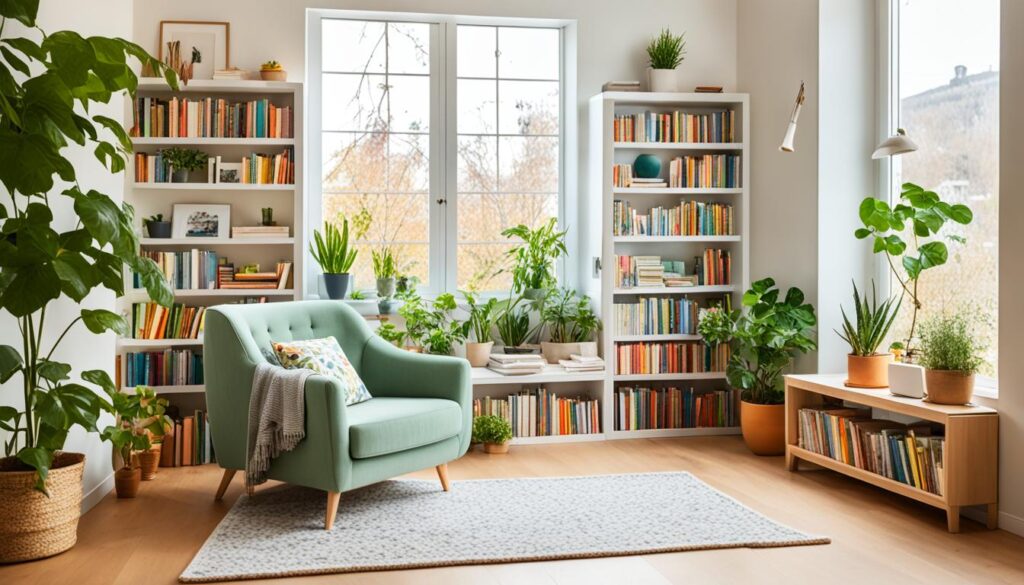
Creating a Centralized Tech Storage Area
Creating a central place for tech can make your home neater. This spot is for storing devices, chargers, and accessories. It stops tech from being scattered everywhere. With everything in one place, families find it easier to take breaks from gadgets. This helps in keeping life simple and less cluttered.
Tips for Effective Tech Organization in the Home
To set up an organized tech area, follow these steps:
- Designate a specific location: Pick a spot that’s easy for everyone to reach. A good place is near the entryway, where you can have a charging station.
- Use storage solutions: Use bins, baskets, or shelves to keep items sorted. Putting labels on these can help you stay organized.
- Ensure charging convenience: Have plenty of charging ports and cables in this area. This keeps devices from getting lost when their batteries die.
- Implement a regular check-in routine: Make time each week to clear out gadgets you don’t use. This keeps things tidy.
- Encourage mindful tech use: Talk about the value of limiting screen time. Focus on activities that are more enriching.
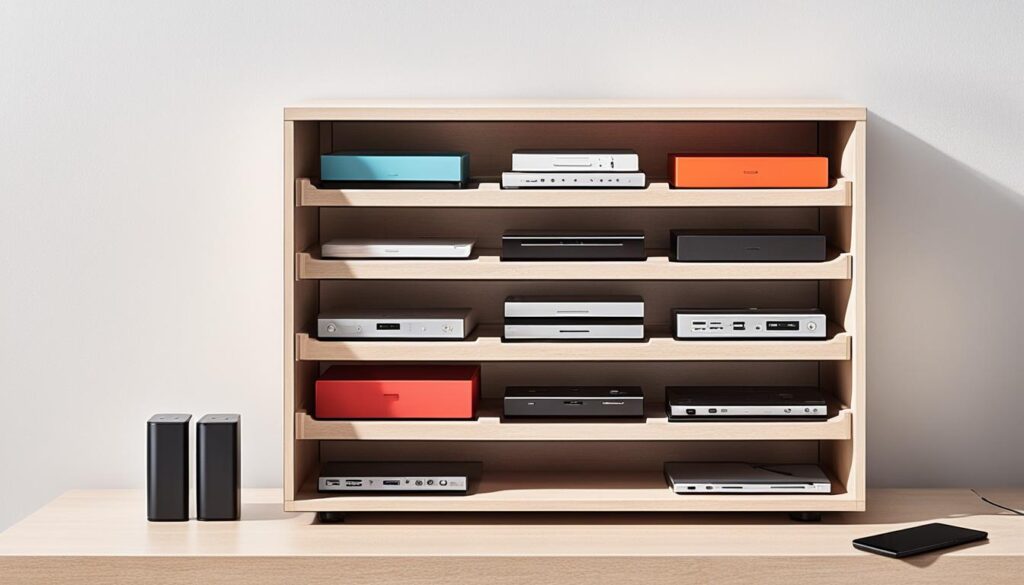
An organized tech area helps people have a better relationship with their gadgets. Putting in the effort to organize can lead to a more balanced life. It allows everyone to connect in real life, free from digital interruptions.
| Tech Storage Tip | Benefits |
|---|---|
| Designate a specific location | Reduces confusion on where devices belong |
| Use storage solutions | Minimizes clutter and creates an organized appearance |
| Ensure charging convenience | Keeps devices charged and ready to go |
| Implement a regular check-in routine | Helps maintain organization over time |
| Encourage mindful tech use | Promotes healthier tech habits |
Creating Outdoor Tech-Free Spaces
Creating spaces outside free from technology is key to a successful digital detox. Being outdoors can make us feel more connected to nature and lessen stress. A study shows that spending time outside can cut stress by half. This shows how powerful nature is in making us feel better.
Setting up certain areas in gardens or parks for tech-free relaxation helps both families and individuals. These Tech-Free Zones let people really experience their environment. They help with reflection and deepen conversations without the distraction of gadgets.
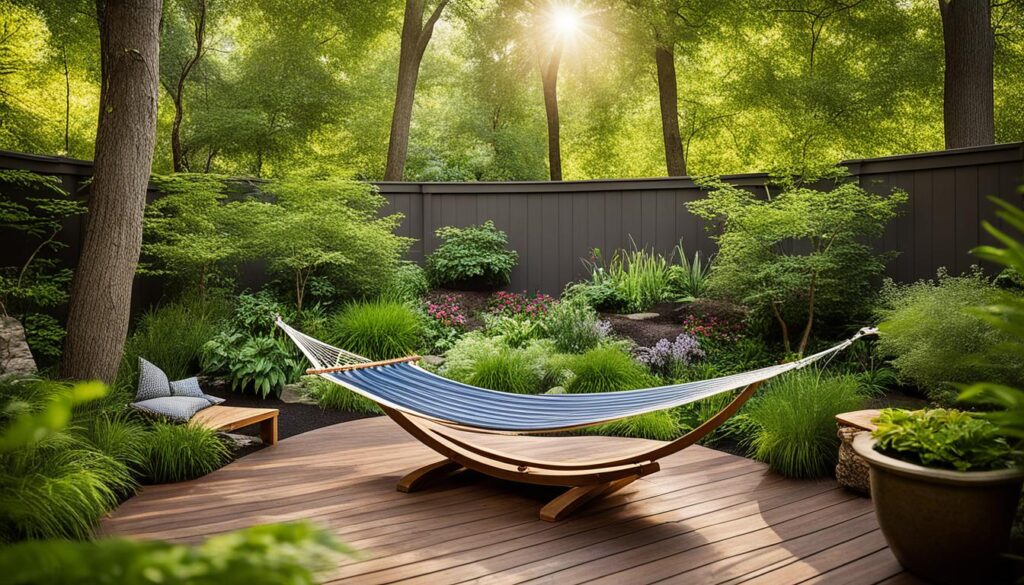
Outdoor tech-free areas also improve how we interact with each other. Sharing meals outside without screens allows for meaningful chats. This can bring people closer together. Families find that eating without screens leads to healthier habits and stronger relationships.
To make outdoor spaces inviting, comfy furniture is crucial. A study in Sydney found that 82% of people like outdoor furniture made of resin wicker with aluminum frames. Such furniture makes it easier to relax and enjoy time away from screens.
| Benefits of Outdoor Tech-Free Spaces | Statistics |
|---|---|
| Stress Reduction | 50% reduction in stress levels when outdoors |
| Healthier Eating Habits | 30% less likely to overeat without screens during meals |
| Social Interaction | Promotes family bonding through tech-free meal times |
| Preferred Furniture Choice | 82% prefer resin wicker with aluminum frames |
Making outdoor areas free from technology really adds to a digital detox. Going for walks without phones or taking up outdoor hobbies helps us disconnect. This not only aids personal growth but also strengthens family ties in nature.
Conclusion
Starting a digital detox and creating tech-free zones boosts wellness and leads to a healthier life. People often see big improvements in mental health, relationships, and happiness with tech-free living. These changes not only reduce stress right away but also promise long-term gains.
Setting up special spots at home, like a cozy reading area or a spot for meditation, helps us pause and reconnect with the real world. Enjoying simple activities, like drinking a soothing cup of tea or deep breathing, adds to the benefits of a digital detox. It strengthens these new habits. Tech-free areas, either designed for peace or ways to enjoy non-digital hobbies, encourage living in the moment.
Tech-Free Tuesday is a planned break from digital devices, letting us enjoy life without screen distractions. Facing challenges like FOMO or work stress can be tough, but being mindful makes it easier. In the end, taking control of our tech use leads to genuine connections and a happier lifestyle.

